Blackfish City is Sam J. Miller’s second novel, the first for adult readers. In a post-climate-collapse world, the floating city of Qaanaaq is a social and technological marvel marked by vast disparities in wealth amongst its populace, ruled in large part by artificial intelligences and mysterious shareholders. The city is on the cusp of upheaval, though, as a viral disease ravages its population without control and the availability of real estate continues to cramp tighter and tighter. However, when a strange woman comes to the city riding an orca whale with a caged polar bear at her side on a mission of revenge, the results will change the entire structure of Qaanaaq.
The reader experiences the novel through various narrators: Kaev, a journeyman fighter working odd jobs for his crime boss ex-lover; Soq, a slide messenger whose gender is an impossible to categorize project and whose motivation is the potential destruction of Qaanaq; Fill, a rich young gay man who is desperately empty of purpose and drive; and Ankit, a political canvas worker for an Arm manager whose campaign is failing. These disparate voices, strung together across the domains of Qaanaaq, unite against odds when faced with a shared foe.
Buy the Book


Blackfish City
Miller has woven a number of pressing contemporary concerns—homelessness, wealth inequality, political corruption, familial bonds, the AIDS epidemic—into the fabric of Qaanaaq, the floating city. Though it has a fast-paced and intriguing political plot, Blackfish City is a novel driven in large part by its conceptual and thematic frameworks. The bits I found most engaging were often the intimate sketches Miller gives of his characters’ interactions with their world. While all of our narrators technically inhabit the same city, the vast gaps in wealth, role, and experience between them make it seem as if they’re all aliens to one another.
The breaks—a virus transmitted through bodily fluids that causes psychological breakage as memories and knowledge leak into the infected from other carriers—is eerie and disruptive. While it is primarily discussed in Qaanaaq as a sexually transmitted disease for deviants, judged by the religious minorities and unacknowledged by the city’s governing AI for mysterious reasons, as the reader sees early on it is also passed through blood contact to children, the poor all living cramped as sardines in Arm Eight, and so forth. The parallels to the AIDs epidemic are direct.
[Spoilers Ahead.]
Miller’s usage of the disease as a unifying vector, one whose “cure” is tied up with the nanobonded who have been hunted almost to extinction, the political and financial corruption of the city at large, and shadowy shareholders manipulating it all from behind the scenes—that’s a distinctly original maneuver to make. Soq in the end adapts the disease that Fill took as a death sentence and uses it to triumph. Evolution and growth, sometimes viral and horrifying, are a path to the future and a source of communal bonding, a way to make one out of many. Metaphor is rarely so apt and effective as it is in this instance.
The narrative construction of Blackfish City is itself almost an echo of the breaks: clips and glimpses and deep-dives into various individual perspectives or connections. The “City Without a Map” selections interspersed throughout are simultaneously disruptive and unifying. As a result, the conclusion of the novel has a loose and uncertain trajectory; various pieces of the conflict fall out across the board—Kaev’s bear dead, Go dead, Podlove mutilated and free—but the final effects are left to interpretation. Soq’s fearless gamble to gain control of the syndicate and enact their desire to do some good in the city is a bright spot, though.
The refusal of a definitive, neat outcome in a sprawling mess of political corruption and economic disparity is the natural thematic conclusion. It did, however, require a second reading of the final chapters to parse the implications. While an intentional mess and an unintentional mess are cousins, narratively speaking, Blackfish City‘s climax hovers between the two. I found it ultimately pleasing as a thematic maneuver, given the impossibility of a conclusive victor in a squabble as large yet individual as the one Miller charts through the novel. The punishment and release of Podlove was in particular a fascinating choice.
The comparison of Go, Podlove, and Soq forms the core of the climactic argument of the novel. Go and Podlove, as Soq observes, are made of the same materials; Soq themselves, however, has decided to wrest the mantle of power not for the sake of their own aggrandizement but for the city that raised them, the poor and destitute they’ve grown up amongst, the beautiful empty rich boy they fucked and who died as a stand-in for his grandfather’s crimes. The potential of change is their motivator—a unifying desire to do the violence that needs doing for the sake of people who need uplifting.
There’s no telling what the results will be in the bid for control of the syndicate, Soq’s meteoric rise to something akin to a shareholder with all the empty real estate they’ve accumulated thanks to Fill infecting them with the breaks, their discovered familial unit of grandmothers, father, and aunt. The lack of certainty is a hopeful openness, though, and an intriguing note to end the novel on. It’s a thought-provoking and ambitious book, one that I found delightful and handsome at turns, a signal of the directions science fiction has to go in as contemporary life continues to evolve at pace. This novel is queer, political, and eager to change the status quo—even if it’s a challenge to conceptualize the path to doing so.
Blackfish City is available from Ecco.
Lee Mandelo is a writer, critic, and editor whose primary fields of interest are speculative fiction and queer literature, especially when the two coincide. They have two books out, Beyond Binary: Genderqueer and Sexually Fluid Speculative Fiction and We Wuz Pushed: On Joanna Russ and Radical Truth-telling, and in the past have edited for publications like Strange Horizons Magazine. Other work has been featured in magazines such as Stone Telling, Clarkesworld, Apex, and Ideomancer.










